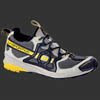More Trail Running Shoe Options
To find more options for trail running shoes, check out our Best Trail Running Shoes article.
La Sportiva Raceblade Review
 When I wear the La Sportiva Raceblade, I often feel like I’m being propelled forward down the trail. This propelled feeling is above and beyond the light weight (12.24 oz/347 g according to La Sportiva) and responsiveness of the shoes and is different from any feeling I get from the La Sportiva Fireblade. (You should check out my review of the Fireblade, as I make numerous comparisons between the Raceblade and Fireblade in this review.) Overall, the Raceblade is a great shoe that is well suited to many uses and, despite the name, the Raceblade has already found a spot in my training shoe rotation.
When I wear the La Sportiva Raceblade, I often feel like I’m being propelled forward down the trail. This propelled feeling is above and beyond the light weight (12.24 oz/347 g according to La Sportiva) and responsiveness of the shoes and is different from any feeling I get from the La Sportiva Fireblade. (You should check out my review of the Fireblade, as I make numerous comparisons between the Raceblade and Fireblade in this review.) Overall, the Raceblade is a great shoe that is well suited to many uses and, despite the name, the Raceblade has already found a spot in my training shoe rotation.
 While perhaps not suited for the rockiest of 100 milers, I found the Raceblade to have plenty of forefoot rock protection. I hope to test it on a 20-30 mile very rocky run sometime soon and suspect it will perform well. The small toe cap also adequately protected my toes when I began kicking waterbars at the end the HAT Run 50k a few weeks ago. I’m also a fan of the Raceblade’s upper – the lace system works well and the integrated mesh tongue effectively blocks trail grit from entering the upper.
While perhaps not suited for the rockiest of 100 milers, I found the Raceblade to have plenty of forefoot rock protection. I hope to test it on a 20-30 mile very rocky run sometime soon and suspect it will perform well. The small toe cap also adequately protected my toes when I began kicking waterbars at the end the HAT Run 50k a few weeks ago. I’m also a fan of the Raceblade’s upper – the lace system works well and the integrated mesh tongue effectively blocks trail grit from entering the upper.
One big plus for the Raceblade is that it remains relatively light even when wet. During an 8+ mile trail run in the pouring rain wearing the Raceblade and a thin pair of Smartwool running socks, my feet never felt heavy. Loved it. This quality makes playing in the puddles even MORE fun!
The Raceblades also fit my feet very well with a nice snug, but unrestricted feel. While the bottom of the Fireblade’s heel cup is just a bit too large for me (contributing to odd linear heel blisters at Old Pueblo), the heel cup of the Raceblade was perfect for my feet.
I’ve try to find drawbacks with the shoe, but they are awfully hard to find. One distinction, which can either be a drawback or a feature, is that you can’t be as lazy running in the Raceblade as you can be when running in the Fireblade. What I mean is that the Fireblade and most other trail shoes have a wider outsoles at the heel that provides additional stability. The wider heel smooths out more unevenness in the trail without you having to think about it. That’s not to say that the Raceblade is not stable and I was paying close attention to this aspect, as I anticipating including it as a drawback. The Raceblades provided more than adequate stability on easy-to-moderately technical trails as well as grass fields. One benefit of narrowing the heel section of the outsole is that it contributes to the shoe’s responsiveness, which the Raceblade has in spades.
One thing the Raceblade shares with the Fireblade is the lugging of its outsole, which was not designed specifically for attacking muddy trails. Both shoes handle occasional mud well and during 7 miles of running on puddle-laced trails in heavy rain, I only noticed the lack of traction on six discrete occasions. Four of those occasions were on very steep climbs with only one instance requiring me to alter my stride (I put one hand out to catch me). The two other instance were on downhills. One was a barely noticeable slip when I was specifically testing the downhill traction. The other downhill slip was on a steep makeshift clay trail late in my run. After some quick investigating, I decided to skip the hill and go down via a more established trail.
In sum, the Raceblade is a light, responsive trail shoe that is well suited for both racing and training.
The Raceblade MSRP is $85. Purchase from Amazon for $78.
You can find out more about the Raceblade
- In the comments left in response to my previously posed questions about the Fireblade and Raceblade; and
- A Running Times review (They agree the Raceblade makes a great light-weight trainer).
As always, please share your experiences with the Raceblade in the comments.

